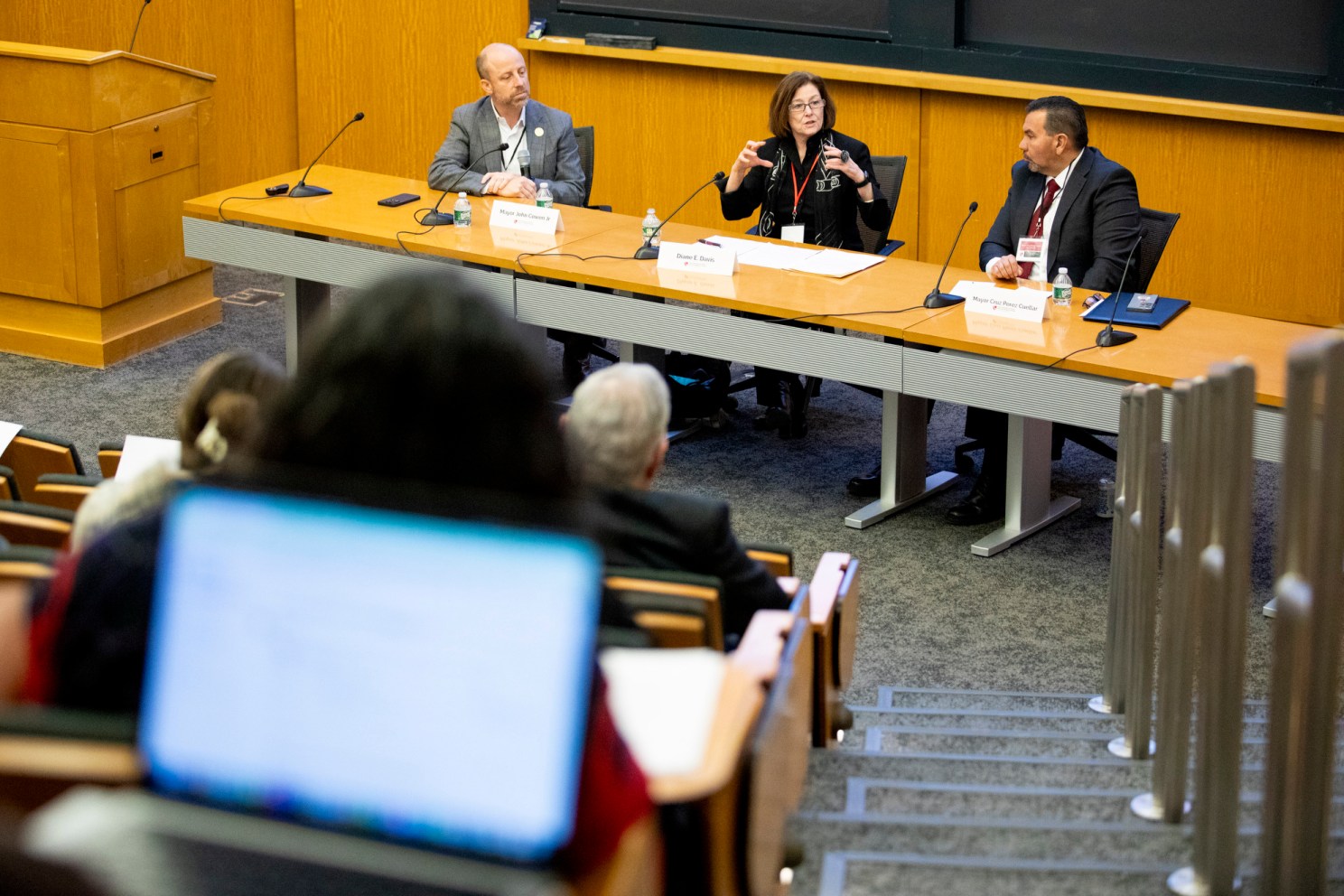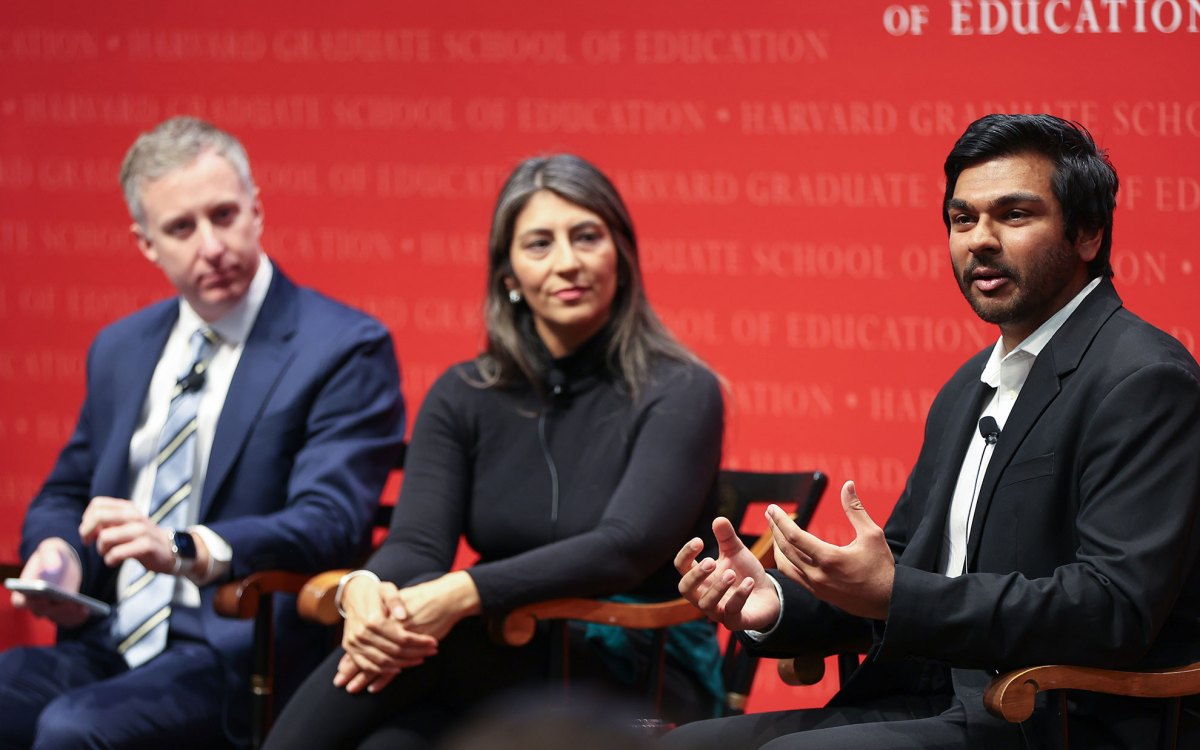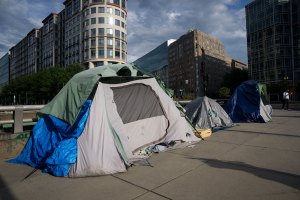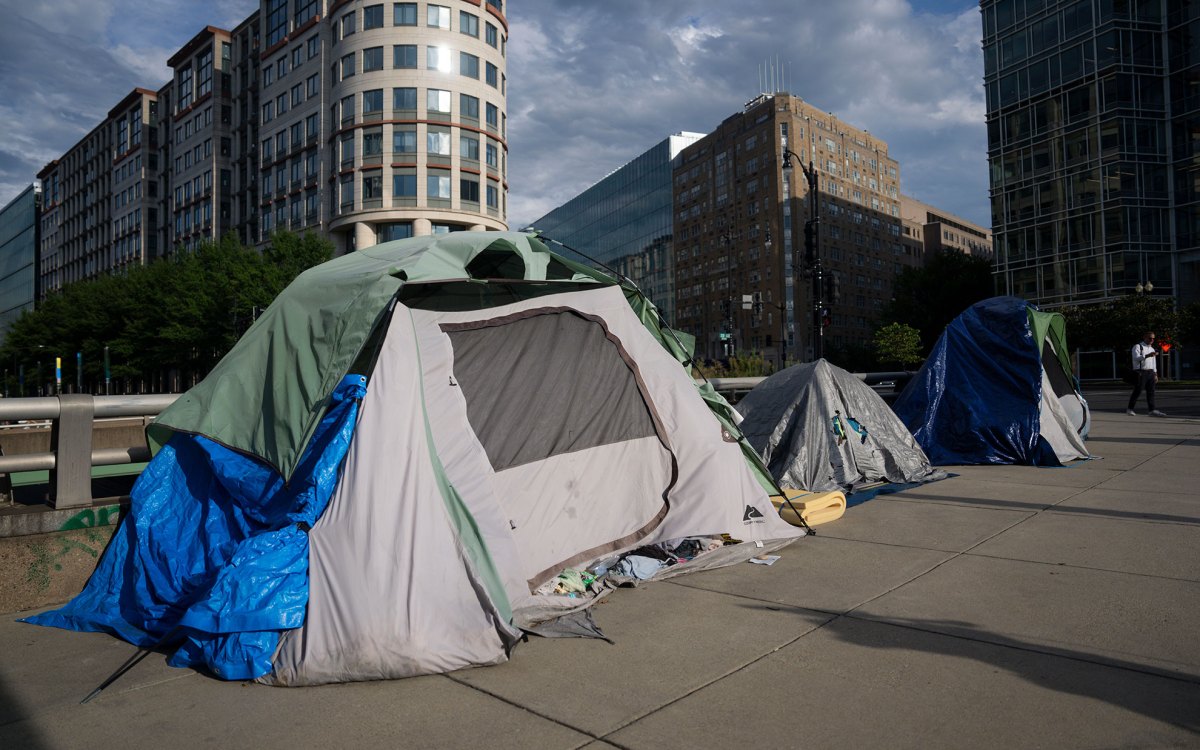
Mayors of Brownsville, Texas, John Cowen (left) and Ciudad Juárez, Mexico, Cruz Pérez Cuéllar (right), join moderator Diane Davis.
Veasey Conway/Harvard Staff Photographer
Separated by a border, but with fates entwined
Mayors from U.S., Mexican cities flanking divide compare notes on immigration, national leadership, tariffs
From afar, the 2,000-mile U.S. border with Mexico appears as a hard economic, political, and cultural boundary. But mayors of cities that flank the divide have a different view.
“We’re a binational community,” said Mayor Carlos Peña Ortiz, HKS ’20 of Reynosa, Mexico, which mirrors McAllen, Texas, across the Rio Grande. “We share values; we share businesses; we share religion; we share families; and we’re basically just divided by a river.”
Three borderland mayors appeared at a recent symposium on U.S./Mexico relations, hosted by the David Rockefeller Center for Latin American Studies. These leaders, currently focused on protecting their local economies, spoke to issues related to immigration, tariffs, and recent presidential transitions in both countries. They also testified to their interconnected fortunes.
“Historically, Brownsville has been very affected by the Mexican peso,” said Mayor John Cowen Jr., who leads the city of 190,000 at Texas’ southernmost tip. “If there’s a big devaluation, our local economy just crashes.”
Moderator Diane Davis, Charles Dyer Norton Professor of Regional Planning and Urbanism at the Harvard Graduate School of Design, kicked off the event by asking how things have changed in light of federal transitions of power. Mexican President Claudia Sheinbaum took office in October, just three months before President Trump returned to the White House in the U.S.
All three mayors described dramatic decreases in migrant flows, with those from Mexico also noting reduced crime. Peña Ortiz estimated a “95 percent” decrease in migrant traffic over the past two months. The second-term mayor couldn’t be physically present at the session as he had to rush home due to flash flooding in the area. Instead he sent a video of himself answering Davis’ questions.
“We’ve seen a very significant drop in most migrant groups,” said Peña Ortiz, who highlighted the appearance of Russian and Ukrainian passports until recently. “Our migrant camps were full for the last eight, nine years. We usually had around 16,000 to 20,000 migrants in our community, and nowadays we have close to 700. … And for the last month, we have not seen a lot of gunfights. Violent crime has dropped significantly.”
“We share values; we share businesses; we share religion; we share families; and we’re basically just divided by a river.”
Carlos Peña Ortiz, mayor of Reynosa, Mexico
The March 28 roundtable, co-sponsored by the Bloomberg Center for Cities at Harvard and the Department of the History of Science, yielded disparate takes on relations with the new administrations in Mexico City and Washington, D.C.
Mayor Cruz Pérez Cuéllar of Ciudad Juárez, across the river from El Paso, Texas, praised the Sheinbaum administration for helping his city of 1.6 million bolster shelter capacity ahead of promised deportations by U.S. Customs and Border Protection.
“For the first time since I was born in Juárez,” he said, “I see a federal government that is concerned about what is going to happen.”
Cowen, elected in 2023 for the nonpartisan position, observed the very opposite. More than 50,000 migrants from 31 different countries passed through the city’s port of entry during his first month in office, he said. “We were able to manage that through a combination of relationships with our federal government, with our NGOs.”
But now he worries about a future influx given the currently shifting state of federal funding. He voiced particular concern over the Federal Emergency Management Agency’s Shelter and Services Program, which helps support local efforts to house migrants.
“But other than that type of funding, we’re looking at cuts to our health programs, our ability to respond to infectious disease,” he added, noting that Brownsville has dealt in the past with Zika and other mosquito-borne illnesses. Also key to the city’s budget, he said, is federal transit funding.
Tariffs proved a top concern, with the Mexican mayors braced for negative impacts. Peña Ortiz worried what border taxes portend for the future of cross-border cooperation on everything from workforce training to preserving water quality.
“Historically, we’ve been working together with programs like NADBank,” he said, referring to a program established by the U.S. and Mexican governments in 1994 to finance critical environmental infrastructure. “But if there’s no collaboration from the U.S., what will happen long-term with water resources here in the border communities?”
Ciudad Juárez investors are waiting for U.S. tariff policy to stabilize, said Pérez Cuéllar, who just visited Taiwan to bolster relations with business leaders there. “The big problem is that huge companies are waiting,” he said. “I talk to them a lot, and they say, ‘Well, we want to keep investing but we have to wait.’”
On the U.S. side, Cowen acknowledged tariffs as a “headwind” for new business ventures. But the city is still benefiting from initiatives launched in recent years. Currently underway at the Port of Brownsville is a massive gas liquification and export terminal, due for completion by decade’s end. New SpaceX facilities are also under construction in the area.
“That’s $40 billion in investments” for a city currently worth $10 billion, emphasized Cowen, a sixth-generation resident intent on lowering the city’s historically high rates of poverty. He was proud to cite a recent Harvard study ranking Brownsville as the top U.S. city for improving intergenerational mobility.




